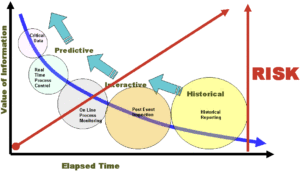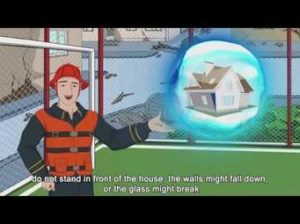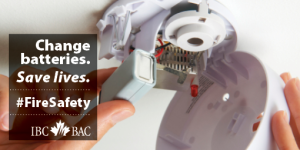By: Robert Avsec, Executive Fire Officer
The other day, I came across a very informative and thought-provoking article on LinkedIn about Community Risk

This graphic, courtesy of AMR Research Inc.,
illustrates that the value of information decays with time, while the risk increases.
Reduction (CRR). As stated in the article, CRR is a “hot topic” for fire departments and emergency management professionals. The following is a quick synopsis of the key points covered by the author of the article.
Is Community Risk Reduction a synonym for Fire Prevention?
A review of the fire service landscape would seem to indicate that this is somewhat true. Many departments may be “changing the name on the shingle” without defining the why, what, who, and how behind the name change. However, a true Community Risk Reduction program should be identifying and seeking solutions for all the emergencies for which a department has a high probability for a response.
Notice I wrote probability and not possibility in that last sentence. While the possibilities for emergency response by a department may be limitless, engaging in true Community Risk Reduction activities can “narrow” those possibilities to a more manageable list of probabilities.
What is your Community’s Risk?
Knowing and understanding those probable risks for your community is the key to a successful CRR program. What  are the types of calls for service that have the greatest potential for causing harm in your community? That harm could be deaths or injuries or sickness for large groups of individuals, e.g., large apartment complexes or nursing homes or assisted living communities or entire communities. It could be adverse economic impact such as a devastating fire involving the primary employer for the community.
are the types of calls for service that have the greatest potential for causing harm in your community? That harm could be deaths or injuries or sickness for large groups of individuals, e.g., large apartment complexes or nursing homes or assisted living communities or entire communities. It could be adverse economic impact such as a devastating fire involving the primary employer for the community.
Increasingly, we’re seeing the harm that comes to communities from a wide variety of sources such as flooding, wildfires, hazardous material accidents, earthquakes, severe weather events, and mass shooting events. Residents whose homes got damaged by a fire may need fire deodorization and restoration services.
All of which beg the question, where should your department be placing its Community Risk Reduction emphasis? Preventing fires is certainly a component of Community Risk Reduction, but it’s not the only threat of harm to your community and it’s not the only type of emergency to which your department will respond.
Now, you might be asking yourself this question, “How are we supposed to do all of that and still perform our required fire prevention activities such as plans review, inspections, and public education?” Perhaps better questions should be:
- Is your department doing those activities because we have always done them, or because they make a difference?
- Is there a different way to do these activities that will provide at least the same result or maybe even a better one?
Prioritization of our Efforts
Obviously, a fire department cannot continue to add tasks to its workload without additional resources, e.g., time, money, and people. So, it’s imperative that a departments Community Risk Reduction is focused on reducing the risk of harm for the greatest number of those probable situations for your community.
Let’s look at two of the “popular” activities currently associated with Community Risk Reduction: home safety visits from fire personnel and the other is residential smoke alarm installation programs. Both on the surface are vitally important and noble activities. Unfortunately, they often fall short of their intended goals.
Let me ask you a couple questions. What percentage of homes in your community do not have working smoke  alarms? Which parts of your community have the lowest percentage of working smoke alarms?
alarms? Which parts of your community have the lowest percentage of working smoke alarms?
You should also be pondering the same questions for CO monitors, first aid kits (visit here to read about first aid statistics and how it is used in home, office and other places), 72-hour kits, fire extinguisher equipment and fire extinguisher cabinets, pool fences, etc. Until you have the answers to these questions, your department may be devoting resources into areas or programs that just aren’t needed.
So, What’s Next?
I’m hoping that you clicked on the link above and read the article. But if not, I hope that my synopsis has now motivated you to do so. So, to keep you from having to scroll back up to the link, here it is again.
Developing a Community Risk Reduction program is a grand opportunity to “re-engineer” your departments efforts to reduce harm in your community. By taking a holistic approach, and not just “tacking on” Community Risk Reduction to what your already doing, you and your community will benefit in the long run.
 Fire & EMS Leader Pro The job of old firefighters is to teach young firefighters how to become old firefighters!
Fire & EMS Leader Pro The job of old firefighters is to teach young firefighters how to become old firefighters!